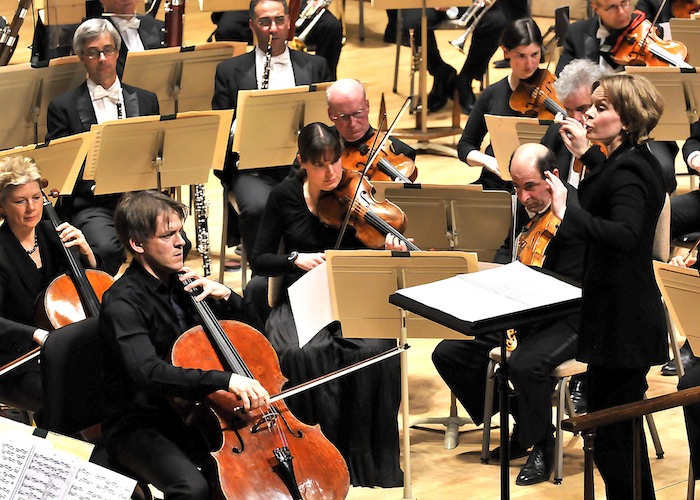Chin’s introspective Cello Concerto given a memorable premiere by Gerhardt, Boston Symphony

Susanna Malkki leads the Boston Symphony Orchestra Thursday night, with soloist Alban Gerhardt in the premiere of Unsuk Chin's Cello Concerto. Photo: Stu Rosner.
In some concertos, soloist and orchestra fall in love. In some, they weave tapestries. In some, they travel different roads toward a common goal.
And in some, they make war. Not infrequently in contemporary concertos, the two forces seem to have scores from different composers.
But in Unsuk Chin’s Concerto for Cello and Orchestra, given a memorable American premiere Thursday evening by soloist Alban Gerhardt and the Boston Symphony Orchestra, the battle gets fought not by two starkly contrasting foes, but two supremely confident and respectful rivals, full of admiration for each other, wrestling for the same rich reward.
The victor? Pointless question. Chin’s superbly tense work, directed with rigor by Finnish maestra Susanna Malkki, stretched sonic boundaries not with atonal inventions but with harmonic and sub-harmonic experimentation. The piece avoided showy virtuosity while placing considerable musical demands on the soloist and the large orchestral forces required.
In four movements, totaling about half an hour, the score calls for extensive strings, more than two dozen winds and horns, and a back row replete with dozens of percussion instruments.
Surprisingly, given the available firepower, the mood is generally reserved and contemplative. The soloist stays active throughout, but often playing drones, or extended glissandos, sometimes mirrored by the ensemble, sometimes fractured by them. A long first movement (marked “Aniri,” invoking a traditional and stylized Korean dramatic form), is mostly contemplative but always active. It ends in a percussive crescendo, and the second movement parlays that immediately into its own extended percussion opening. But that ends quickly, and quietly. The second movement, marked “Energico,” lasts only a few minutes.
The third, given only a metronome marking, begins with a cello drone that briefly centers the musical action, before the struggle for a harmonic center begins again. The finale, also designated only by its metronome beat, swells to a huge crescendo toward the middle, but subsides almost completely, with the work ending in a fragile, exposed note in the cello’s highest registers.
Malkki treated the soloist, appropriately, like a singer, allowing the “text” of the cello’s line to dictate the pace, steering the orchestra, as best she could, toward a reconciliation of harmonic contrasts. This was a battle of wills, its “outcome” in the end still in dispute, but thrilling to witness. Gerhardt’s return after intermission for the affecting but slight Silent Woods of Dvorak seemed like an encore.
The rest of the repertorially diverse program included Haydn’s Fire symphony (No. 59) and the Sibelius Fifth symphony. Malkki had a solid sense of each work’s purpose, stretching the concluding Sibelius to its interpretive limits.
The program repeats 7 p.m. Friday and 8 p.m. Saturday; bso.org; 888-266-1200.